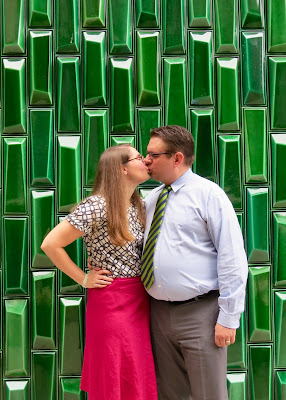My wife and I have had a disagreement for most of our marriage. It is a minor thing, but I have a polo shirt that she insists is grey but I was pretty shirt was slightly green.
I should note that I am slightly color blind in the green region, so for the most part I didn't argue with her about this. But I always believed that it was green. I knew it wasn't kelly green or seafoam green or even moss green, but more grey with a hint of green.
I recently started a new job as a software developer for The Home Depot, as readers of this blog already know. My second day on the job they had me work in one of the stores so I would understand the company's core business. While I didn't plan this, I just so happened to wear my grey/green shirt to work that day.
After I finished my shift I went up to the paint counter. There they have a calibrated colorimeter, a device for measuring the exact color of an object. This is how they are able to match paint colors to the color of an object a customer brings in.
I asked them to measure my shirt After a surprised and slightly quizical look from the girl behind the counter she pulled the machine and measured the color of my shirt.
The machine spat out some giberish numbers that meant something to their paint mixing machine, like a recipe for color. Me being more knowledgeable about computers than paint I didn't understand what this meant. Fortunately the computer also told them the names of the closest premixed paint buckets they had. The closest to my eye is the Behr paint called Chinchilla. It was a perfect match to my shirt.
The problem was it looked a little green to me as well. This didn't prove anything though since I didn't have any numbers that meant anything to me, but I had a name.
I found that Behr has an app for my Android phone. I put in the color name and it displayed that color on my phone's screen. I took a screenshot of the app and opened the image in the Photo Editor app on my phone.
I isolated the paint color from the screenshot and increased the saturation and brightness of the color, leaving the hue of the color alone. If there is any color at all in this sample, this process amplifies it and makes it visible.
As you can see from the screenshot above, If there is any color at all in my shirt it is orange. Not green, not where near green. It is closer to red than to green.
That number at the stop that starts with FF describes the color in base 16 numbers (that is why there letters in it). That means that on a scale from 0 to 255, the transparency is 255 (not transparent), red is 106, green is 102, and blue is 98. They are all very close which is why this color appears grey. Red has the highest number making it dominant. Since green is higher than blue the color is shifted toward green slightly, but just enough to move it toward orange, not even getting past yellow. For this shirt to appear green, green would have to be the highest value in the chart.
I am enough of a man to admit it publicly, my wife was right and I was... less right. No, I was flat out wrong. This shirt isn't even slightly green. With how little difference there is between the values (1.5% difference) the shirt is solidly in the grey category.

























